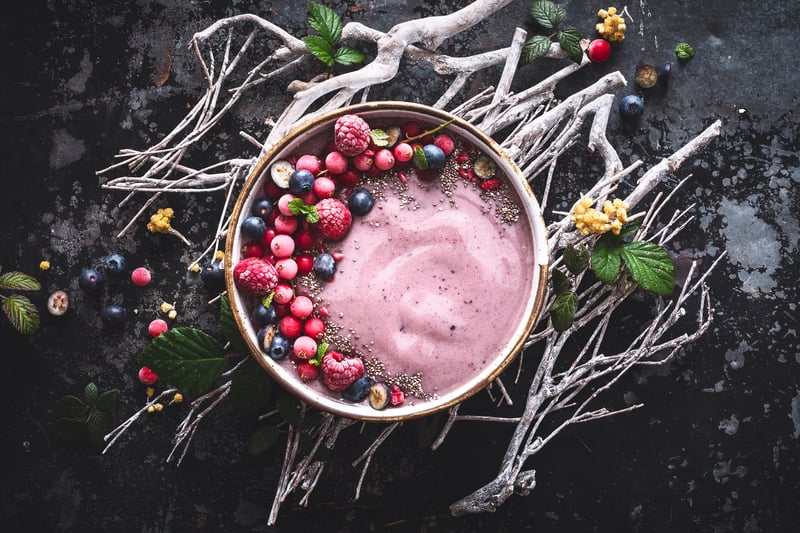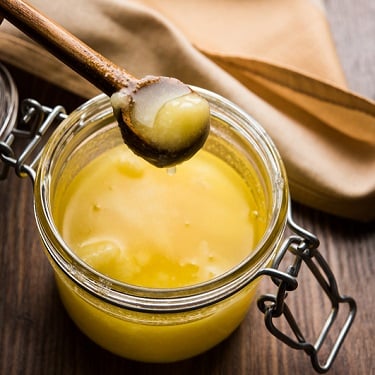Are Acai Bowls Healthy? See the Calories and Nutrition

If you’re scrolling through images on Instagram or recipes on Pinterest, you’ve likely come across some beautiful images of a delicious, almost frozen yogurt (or sorbet)-like amethyst bowl topped with coconut flakes, fresh fruits, a drizzle of nut butter, and perhaps some other goodies. Acai (pronounced Ah-sigh-ee) bowls are promoted as delicious and highly healthy ways to increase the nutrient density of your diet. But are acai bowls healthy, really? Do they live up to all the hype?
What’s In Your Acai Bowl?
It’s no surprise that acai bowls vary dramatically depending on where you’re getting them. Most start with the unusual nutrient-dense fruit acai. This grape-like berry grows on acai palm trees, which are native to rainforests in Central and South America. The berry is around 80% seed and 20% flesh, and most people completely discard the seed. But before eating, the fruit is typically soaked (to soften the skin) and then mashed into a paste.
This colorful berry is low in calories (70 per 100 grams). It also provides healthy fats (5 grams), is lower in carbs with just 4 grams, including 2 grams of sugar and 2 grams of fiber. And it contains nutrients like vitamin C (as much as blueberries), vitamins A, B1, B2, B3, and E, and minerals like calcium, chromium, zinc, iron, copper, manganese, magnesium, and potassium.
Most notably, acai berries are rich in anthocyanins, which give the fruit its beautiful jewel-like purple color.1 Anthocyanins are powerful antioxidants, which are also found in blue, black, and purple foods, such as blueberries, blackberries, grapes, cherries, red cabbage, eggplant, and even black beans.
Antioxidants are important for the diet as they fight oxidation. This process occurs when the body interacts with toxins, including air pollution, excess sunlight, alcohol, and everyday life, which can lead to free radicals. Free radicals are unpaired electrons that can then steal electrons from other molecules.
Oxidation is a natural process. But it can get out of hand, and too many free radicals can lead to cell damage and may even lead to cancer, heart disease, and other diseases. 2 This explains why foods high in antioxidants, such as acai, are so highly recommended.
Another reason acai berries have gained popularity is because they don’t contain a lot of sugar. That, however, means they can taste pretty bitter and earthy. Yet, if you’ve even had one, you know that acai berry bowls are far from bitter tasting. In fact, they’re deliciously sweet, often compared to frozen yogurt or sorbet for their flavor and consistency.
Unfortunately, that sweet flavor isn’t from the fruit alone. Rather, it’s because many of them have high amounts of added sweeteners, including natural or artificial sweeteners, honey, or syrups. They can also be made with sweetened milk alternatives, such as a nut or soy milk.
The History of Acai Bowls
Acai bowls originated in Brazil, where they were claimed to boost energy levels, promote immunity, and support detoxification. In South America, the frozen pulp of the berries is typically topped with bananas and some granola and sometimes also contains the energizing fruit guarana, which is a natural stimulant.
In America, the fresh fruit is difficult to keep fresh as it goes bad quickly. Especially since these berries are grown in Central and South America, instead of using whole fresh or frozen fruit, often acai bowls are made from a powder that contains freeze-dried acai powders or purees along with other ingredients like pomegranate powder and added sugar. The bowl is then topped with several additions, including sliced fruits, such as banana, kiwi, mango, and berries, and topped with nuts, seeds, nut butters, coconut, or even chocolate. Other additions can include agave, apple juice, sweetened almond or soy milk, honey, mango juice, pomegranate seeds, and more.
By now, if you suspect the typical acai bowl served in America is more often a sugar bomb than a healthy snack, you’re on the right track. This is especially true when granola, chocolate, sweetened coconut, honey, or maple syrup are part of the recipe.
Acai Bowl Nutrition Facts
If you decide on a traditional Brazilian acai bowl (i.e., frozen acai, bananas, and granola), you’ll enjoy a filling dish that provides around 355 calories with 50 grams of carbohydrates, including 18 grams of sugar.
At the grocery store, you can also find unsweetened acai puree packs, which provide (per serving):
- 70 calories
- 5 g fat
- 4 g carbs
- 3 g fiber
- 0 g sugar
- 1 g protein
In America, though, we tend to go bigger, especially when it comes to sugar. For example, Sambazon Acai Superfruit Packs contain (per serving) 100 calories with 3.5 grams of fat, 15 grams of carbs, 3 grams of fiber, and 12 grams of added sugar in the form of organic cane sugar.
If you pick up an Acai Berry Bowl from Juice It Up, it’s made with acai, strawberries, blueberries, strawberry juice blend, and guarana and provides:
- 340 calories
- 8 g fat
- 66 g carbohydrates
- 60 g sugar
- 5 g fiber
- 2 g protein
Juice it Up also offers an Ultimate Acai Bowl with 64 grams of sugar and 73 grams of carbohydrates. Another brand called Acai Especial Bowl from Robeks is made with acai puree, blueberries, and bananas and topped with bananas, strawberries, blueberries, and granola. Yes, it’s high in vitamin C as well as fiber. But it also comes with 69 grams of sugar and 440 calories. Jamba Juice offers an Acai Primo Bowl with 65 grams of sugar and 520 calories.
You can also purchase acai bowls at many grocery stores. Beware of the serving size, though, as many contain two or more servings, and if you eat more than one serving, you’ll get much higher calories and sugar than you may have bargained for.
Even if most of these sugars are from fruit (though many have added refined sugars), that’s a lot of sugar at one time, which can increase calorie content and have significant impacts on blood sugar levels. And remember, that’s without any of the popular toppings, including additional fruits. It also explains why acai bowls with 90 plus grams of sugar and well over 500 calories aren’t uncommon. Ouch!
If you consider an acai bowl and occasion sweet treat that beats a bowl of ice cream in terms of nutrients, great. If you think you’re eating it daily as a healthy breakfast or snack, you may be pushing the sugar and calorie levels too far.
Are Acai Bowls Healthy? A Wrap-Up
As usual, the answer is, it depends. Sure, a whole-food fruit and nut bowl can be high in nutrient density. But it can also contain a lot of excess calories and sugars. They can also be low in protein and healthy fats, which could help decrease the sugar spike.
Fortunately, you can make a better (i.e., healthier, lower-calorie) acai bowl. Here’s how:
- Break up one serving of unsweetened frozen acai and place in a blender with half a frozen banana.
- Add a serving of leafy greens like spinach or kale or even zucchini or cauliflower, which can add creaminess without affecting the flavor or color as much as greens. Pumpkin puree is another popular addition that provides sweetness, creaminess, and fiber.
- Add a splash of water or unsweetened milk of your choice (such as almond, coconut, oat, or dairy).
- Stir in some collagen or protein powder, chia seeds, or Greek yogurt, as proteins and fat provide staying power to help you feel fuller for longer. They can also support more stable blood sugar levels.
- Blend until it reaches a thick, creamy, frozen yogurt-like consistency.
- Pour into a bowl.
- Top with a half cup of fresh berries and a tablespoon of your favorite nut (or seeds). Remember to watch your serving sizes to ensure you don’t go overboard on calories.
This nutrient-rich option (in this case, made with unsweetened acai puree, ½ banana, 1 cup spinach, 8 oz Greek yogurt, ½ cup berries, and a tablespoon of chopped walnuts) provides 378 filling calories, 15 g fat, 37 g carbs, 7 g fiber, 27 g protein, and only 19 g of natural (none added) sugars.
If you want to add more berries to the smoothie bowl to sweeten the puree, consider skipping the fruit on top. And avoid the toppings with lots of added sugars, such as sweetened coconut, granola, or chocolate bites.
If you’re short on time, you can also find a fairly affordable organic acai bowl at Trader Joe’s that provides just 260 calories, 10 g fat, 44 g carbs, 9 g fiber, 18 g sugar (with only 2 g of added sugars), and 4 g of protein. If you’re looking at acai bowls at your favorite smoothie shop or grocery store, read through the nutrition facts and ingredient list to ensure you’re not overloading on sugar.
What if you want an acai bowl but can’t find any acai? Good alternatives include blackberries and blueberries, as these other purple fruits have similar nutrient profiles.





 US Doctor: "Eating This Every Day Can Snap You Into Ketosis"
US Doctor: "Eating This Every Day Can Snap You Into Ketosis" 3 Key Nutrients to Help Lubricate Your "Tin Man" Joints
3 Key Nutrients to Help Lubricate Your "Tin Man" Joints AVOID Plant-Based Protein Powders (unless...)
AVOID Plant-Based Protein Powders (unless...)

